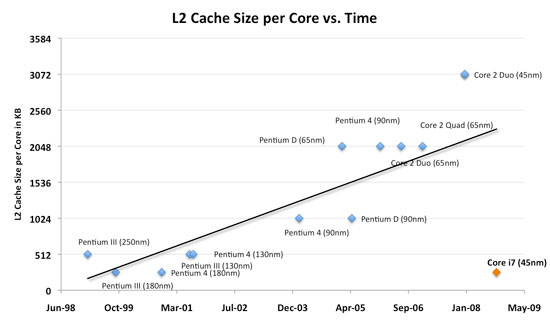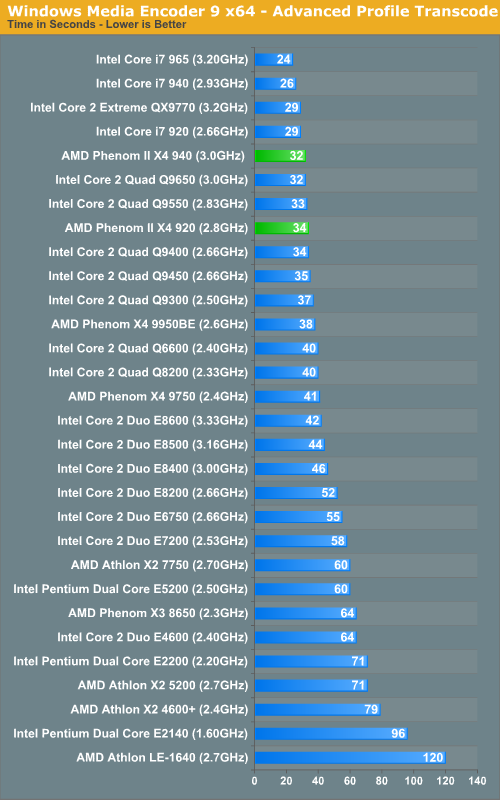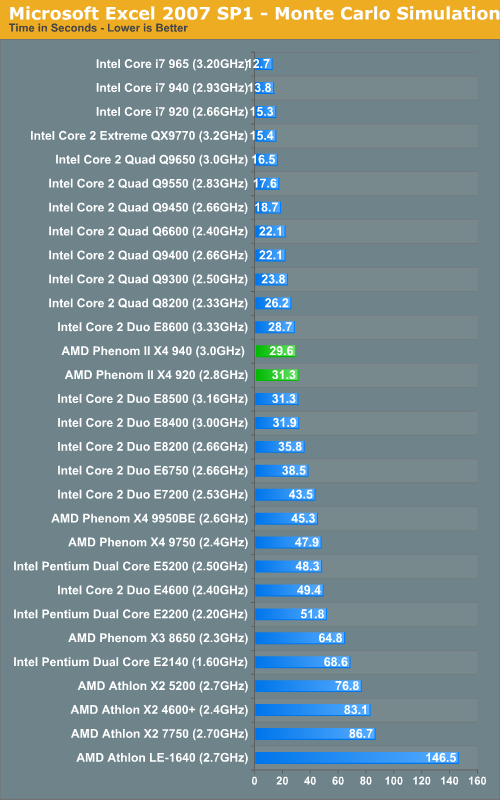
Original Link: https://www.anandtech.com/show/2702
AMD Phenom II X4 940 & 920: A True Return to Competition
by Anand Lal Shimpi on January 8, 2009 12:00 AM EST- Posted in
- CPUs
The AMD we used to know and love is back. As I write this sentence, most of AMD is still on vacation. By the time you read this, that will have changed, but it's such a stark contrast to what happened when the original Phenom processor launched. In the months leading up to Phenom, AMD treated it like it would be its hero. "Just wait", we were told. So we did. And Phenom was the biggest disappointment AMD had ever left us with.
AMD re-launched Phenom the following year, in 2008, with slightly better reception. The CPU evolved from something unsellable to an honest alternative to Intel's CPUs, just not one we'd recommend. Phenom ran too hot, didn't offer better performance, and offered some strange behavior with Cool'n'Quiet enabled.
While AMD was very excited about the first Phenom, we heard relatively little about Phenom II. The first time we heard the name was at AMD's Financial Analyst Day a couple of months ago, and then a month later we had a chip. AMD invited us to overclock the CPU, but I was busy working on another AMD story at the time and couldn't make it. I was done with flying around for AMD CPU launches; if Phenom II was going to be good, the chip would have to prove itself without an exotic locale or delicious Texas BBQ to sweeten the deal.
And good it is.
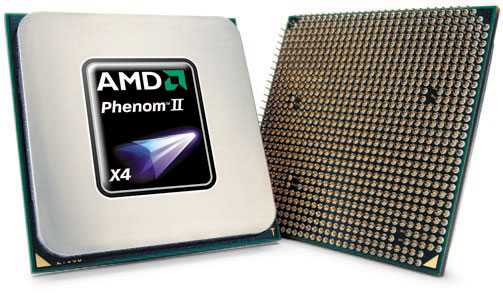
AMD is launching two new 45nm Phenom II CPUs today. There's the Phenom II X4 940 at 3.0GHz and the 920 at 2.8GHz. I'll go ahead and say that although it's a little long, I like the name. The II just works. I'm also feeling a bit chipper, so I'll go ahead and give you the conclusion now too.
Here's how it breaks down. The Phenom II X4 940 is usually the same speed or faster than Intel's Core 2 Quad Q9400, and priced similarly at $275. There are some areas where the Q9400 will be faster than the Phenom II X4 940, so if you happen to use an application that runs better on Intel hardware then you've got your choice made out for you. But for the most part, if you're buying a quad-core processor at around $275 today, Phenom II will tempt you.
Similarly, the Phenom II X4 920 is generally better than or equal to Intel's Core 2 Quad Q9300, and priced less (it's more of a competitor to the slower Q8300, but I didn't have one available for testing). The same stipulations detailed above exist here as well; there are some areas where Intel is going to be faster but for the most part our tests showed the Phenom II to be a better option.
Wait, what? An AMD CPU recommendation?
After over two years of us recommending Intel's Core 2 lineup almost exclusively, AMD finally released a real alternative, one that's not just similarly priced, but actually higher performing than the price-competitive Intel part. Over the coming pages I'll explain how.
Now Intel could've spoiled the party, it still has the performance crown and it could easily drive CPU prices even lower. But out of the kindness of its heart, there are no unexpected price cuts, no new product introductions, nothing to spoil AMD's day (yet). While I'll talk about what Intel may do to restore its leadership at these price points, today is all about Phenom II. If you've been waiting for an AMD to be excited about for the past couple of years, today is your day.
Competition is back. Let's get to it.
The Phenom Inspired, Core i7-like, Phenom II
Want to hear something funny? When AMD launched the original Phenom, it was a unique looking architecture, something AMD touted as a significant advantage due to its "native" monolithic quad-core design (four cores, one die). I often argued that it wasn't an advantage, simply because the performance numbers didn't back up AMD's claims. AMD never won a real world desktop benchmark because of the monolithic quad-core design.
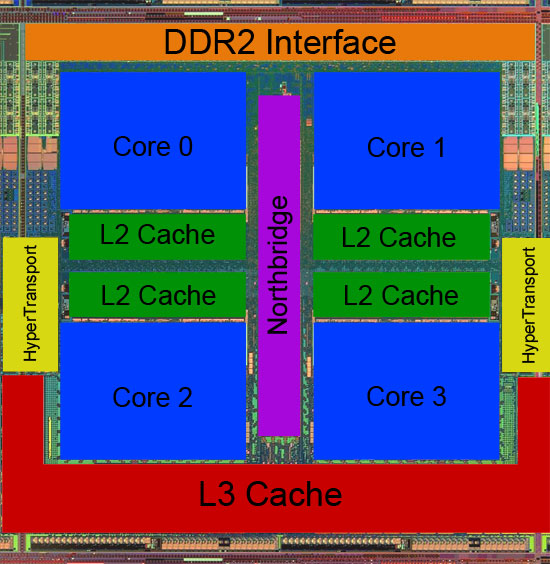
Intel followed up with Nehalem (Core i7), a microprocessor that had a very Phenom-like cache hierarchy (four cores, private L2 caches, one large shared L3 cache), but with much better performance.
Phenom II builds upon the same architecture as the original Phenom, hardly changed, but improves on a few key limitations. This isn't a new microarchitecture, this is a 45nm shrink of Phenom. In a sense, AMD gave up on improving the original Phenom. Early on after Phenom's release AMD went head in the sand and did whatever was necessary to make the 45nm transition perfect. Deneb, as it was called internally, had to succeed - because AMD as a company wasn't going to survive on the backs of the GPU division forever. It's somewhat ironic that Intel was able to execute a better Phenom-like microarchitecture before AMD.
| Processor | AMD Phenom II | AMD Phenom | Intel Core i7 | Intel Core 2 Quad Q8xxx/Q9xxx |
| Manufacturing Process | 45nm | 65nm | 45nm | 45nm |
| L1 Cache | 64K + 64K per core | 64K + 64K per core | 32KB + 32KB per core | 32KB + 32KB per core |
| L2 Cache | 512KB per core | 512KB per core | 256KB per core | 2x3MB, 2x4MB or 2x6MB |
| L3 Cache | 6MB | 2MB | 8MB | - |
| Transistor Count | 758M | 450M | 731M | 456M (6MB/8MB L2) or 820M (12MB L2) |
| Die Size | 258 mm2 | 285 mm2 | 263 mm2 | 164 mm2 (6MB/8MB L2) or 214 mm2 (12MB L2) |
The above chart details the specifications for the current AMD and Intel quad-core offerings, and here we see a problem. Phenom II and Core i7 are around the same die size and have similar transistor counts, yet Core i7 sells for $284 - $999 while Phenom II sells for $235 - $275. The part that Phenom II actually competes with is the Core 2 Quad Q9400 (and perhaps the Q9550; more on that later), and that's a ~36% smaller die. This is the downside to AMD's pricing strategy; while it's great for consumers it's not particularly great for AMD's profit margins. The other thing to keep in mind is that at 214 mm2 Intel has an entire line of quad-core processors that, in theory, could be moved down the price list if the price wars of 2008 were to continue into 2009.
The move to 45nm was severely needed as you can see by the table above. AMD and Intel seem to agree on the right way to build a quad-core processor today: four cores with individual L2 caches (or one shared L2 per two cores on Intel) behind a large global L3 cache. Intel, however, waited until the 45nm transition was complete to move to that sort of an architecture in order to outfit the chip with a large enough L3 cache. AMD jumped the gun early with Phenom and was forced to limit its L3 cache size to 2MB on 65nm. Finally, with the move to 45nm, Phenom II boasts a 6MB L3.
The transistor counts of Phenom II and Core i7 are surprisingly close, as are the die sizes. The two chips are designed completely differently, but the end result is similarly sized processors. Note that both Phenom II and Core i7 are too big for high volume mainstream markets; the die size would need to be around half of what it is now to address those markets. AMD and Intel will do so by introducing dual (or triple in the case of AMD) core versions at 45nm and then transitioning almost exclusively to quad-core at 32nm.
Phenom II also marks AMD's return to the >$200 CPU market. The two parts launching today are the Phenom II X4 940 and the Phenom II X4 920, priced at $275 and $235 respectively.
| Processor | Clock Speed | Uncore Clock | L2 Cache | L3 Cache | TDP | Price |
| AMD Phenom II X4 940 | 3.0GHz | 1.8GHz | 2MB | 6MB | 125W | $275 |
| AMD Phenom II X4 920 | 2.8GHz | 1.8GHz | 2MB | 6MB | 125W | $235 |
| AMD Phenom 9950 | 2.6GHz | 2.0GHz | 2MB | 2MB | 140W | $174 |
Phenom II's Secret, In Pictures
I can be verbose, I know, I'm sorry - I'm working on it. But on this page, I'll use pictures to illustrate my point. Here's the 65nm Phenom die:
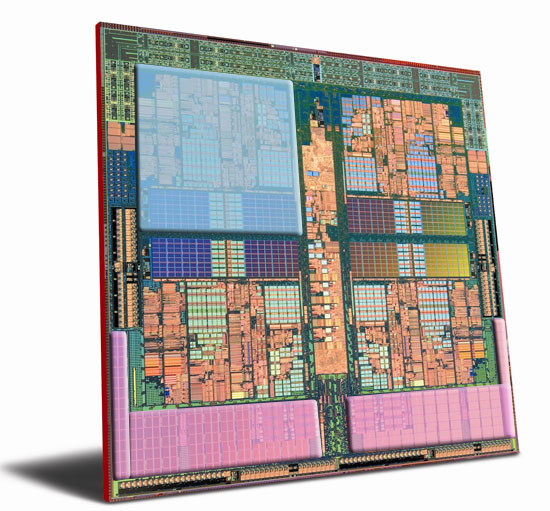
I highlighted one of the four cores in blue. The bottom part of the highlighted core its its 512KB L2 cache. The areas in pink are the 2MB L3 cache that is shared by all four cores. Now look at Phenom II:

Again we've got one of the four cores highlighted blue. The L1 cache size and the core itself look very similar to the original Phenom, but note how the new die is much more rectangular. The pink area represents the Phenom II's 6MB L3 cache.
Just comparing the two die you can see that while the individual cores look similar, the amount of L3 cache has gone up considerably. Remember that Intel found with Nehalem that an 8MB L3 cache was the bare minimum, leaving 2MB per core. The original Phenom had 2MB to share amongst all four cores, which is hardly enough; Phenom II fixes that. With a 6MB L3 cache and 512KB L2 per core, Phenom II looks a lot more like Core i7 from a compute-to-cache ratio:

Nehalem's layout makes a little more sense, with each core butting up against the shared L3 cache, but the point is that in both Phenom II and Core i7, the L3 cache is around 1/3 of the total die. The original Phenom alloted only 1/6th of the die for its L3.
Clock for Clock, Still Slower than Core 2 & Core i7
It was important on the last page to point out that the predominant difference between Phenom and Phenom II is the larger L3 cache; although there are minor architectural tweaks we're fundamentally looking at a core that remains very similar to the Phenom it replaced. The larger L3 cache helps Phenom II stay fed more frequently without painful trips down main memory lane, but Intel's architectures should still be faster at the same clock speed. To prove that point let's look at the following data. It's a subset of the benchmark suite for this article and what we've got below is Phenom II, Core i7, and Core 2 Quad all running at 3.0GHz (the Core i7 runs at 2.93GHz):
| Processor | Clock Speed | Adobe Photoshop CS4 (lower is better) | x264 Pass 2 | 3dsmax 9 | Cinebench | SYSMark 2007 Overall | Left 4 Dead | FarCry 2 |
| AMD Phenom II X4 940 | 3.0GHz | 24.2 s | 17.8 fps | 10.8 | 12393 | 182 | 116.2 fps | 48.2 fps |
| Intel Core 2 Quad Q9650 | 3.0GHz | 19.4 s | 19.9 fps | 12.0 | 12983 | 209 | 125.2 fps | 61.9 fps |
| Intel Core i7-940 | 2.93GHz | 15.8 s | 29.2 fps | 16.2 | 17346 | 229 | 123 fps | 71.0 fps |
| Core 2 Quad Q9650 Advantage | - | 19.8% | 11.8% | 11.1% | 4.8% | 14.8% | 7.7% | 28.4% |
| Core i7-940 Advantage | - | 34.7% | 64% | 50% | 40% | 25.8% | 5.9% | 47.3% |
| Core 2 Quad Q9650 Disadvantage | $265 | |||||||
| Core i7-940 Disadvantage | $295+ | |||||||
Clock for clock, Intel has the advantage across the board. It gets very close between Phenom II and Penryn (Q9650) under Cinebench, but 3dsmax 9 shows a wider gap of 11% between the two. Gaming also looks pretty close if you look at Left 4 Dead; however, Far Cry 2 (a newer engine and much more heavily threaded game) is on the opposite end of the spectrum. The take away point is that compared to Penryn, Phenom II is slower clock-for-clock. The gap grows with Nehalem; Phenom II only gets close in older game engines, while the rest of the time Nehalem is 30-60% faster at the same clock speed.
What matters isn't just absolute performance however, it's performance at a given price point. The last two rows tell an important story; while Intel is faster at the same clock speed, the CPUs themselves cost twice as much as AMD's Phenom II. Nehalem's cost premium is even higher as X58 based motherboards are still above $200, plus they require DDR3 memory. It doesn't matter that AMD won't win the absolute performance crown with Phenom II; like the Radeon HD 4800 series, what's important here is whether or not AMD is competitive at the performance mainstream price points. It's this question that we'll be answering over the course of today's review.
Core i7: Total Cost of Ownership
While Intel's Core i7 is undeniably the fastest CPU on the market today, it comes at a steep cost. The i7 920 is competitively priced at $295, and outperforms the Phenom II X4 940 across the board, but it will only work with DDR3 memory and requires an X58 motherboard - and those are currently selling for no less than $200. The table below summarizes the problem with comparing Nehalem to Phenom II:
| Processor | CPU | Motherboard | Memory* | Total Cost |
| AMD Phenom II X4 940 | $275 | $120 | $75 | $470 |
| Intel Core i7-920 | $295 | $210 | $150 | $655 |
| Intel Core 2 Quad Q9400 | $270 | $100 | $75 | $445 |
Despite the similar CPU costs, the motherboard and DDR3 memory costs make the i7-920 a 40% more expensive purchase. For the difference in platform cost you could purchase a faster graphics card, bigger hard drive, or even put money towards an SSD. Core i7's total cost of ownership keeps it from being Phenom II's direct competition; instead Phenom II is really competing with Intel's 45nm Core 2 Quad processors.
While X58 motherboards will always be pricey thanks to the high-end chipset costs (the minimum pricing we're hearing is $185), DDR3 prices should fall over time, especially once AMD starts moving over to DDR3 in the coming months. Right now DDR2 is incredibly affordable, working in AMD's favor.
With Core i7 out of the running, our eyes turn to Core 2 Quad as Phenom II's intended competition. The table above hints at the Q9400 as Phenom II's competition today, but let me flesh things out a little more:
| Processor | Clock Speed | Cache | 1K Unit Cost |
| Intel Core 2 Quad Q9650 | 3.00GHz | 12MB L2 | $530 |
| Intel Core 2 Quad Q9550 | 2.83GHz | 12MB L2 | $316 |
| AMD Phenom II X4 940 | 3.0GHz | 2MB L2 + 6MB L3 | $275 |
| Intel Core 2 Quad Q9400 | 2.66GHz | 6MB L2 | $266 |
| AMD Phenom II X4 920 | 2.8GHz | 2MB L2 + 6MB L3 | $235 |
| Intel Core 2 Quad Q8300 | 2.50GHz | 4MB L2 | $224 |
| Intel Core 2 Quad Q8200 | 2.33GHz | 4MB L2 | $193 |
| Intel Core 2 Quad Q6600 (65nm) | 2.40GHz | 8MB L2 | $183 |
Other than the Q6600, all of the CPUs in the above chart are 45nm parts (congrats AMD). But look at where the Phenom II slots in. The Phenom II X4 940 is slightly more expensive than a Q9400, while the 920 is a Q8300 competitor. With Core i7's platforms pricing it out of the comparison, the table above should indicate what you need to look at when comparing Phenom II and Core 2 Quad.
I'll mention this briefly here (and more later). Pay close attention to the Q9650 and Q9550. Intel has the ability to move those down the price list, whereas the Phenom II X4 940 is going to be the fastest Phenom II out for the next couple of months.
Ok, I lied, Intel Spoils the Party. Rumored Intel Price Cuts
At the end of last year Intel made some minor price cuts across its product lineup. There was no reason to do anything more serious as AMD hadn't even begun to threaten anything above the Core 2 Quad Q6600.
I've heard, through reliable but very quiet channels, that before the end of January Intel will aggressively cut prices on its entire quad-core lineup. Given how Intel historically cuts prices, we could expect the Core 2 Quad Q9550 would take the place of the Q9400 and have the Q9400 move down to the price point of the Q8300, thus creating a price war; and you thought 2008 was the last of that.
If Intel were to push its prices down like that, the Q9550 would compete with the Phenom II X4 940, and the Core 2 Quad Q9400 would go up against the Phenom II X4 920 instead. If this happens, the conclusion I mentioned on the first page changes. The Phenom II X4 940 can't beat the Q9550, and the 920 can't beat the Q9400. Intel has the ability to do this; it's got faster chips that are more expensive and has just enjoyed 2+ years of unchallenged competition. The Intel from the Pentium 4 days may have let AMD launch Phenom II unchecked, but today's Intel is much more...dynamic.
The take away is that today Phenom II competes with the Q9400 and the Q8300, but by the end of this month that may change to the Q9550 and Q9400.
Cache and Memory Controller Comparison
Now that you know what parts to compare, let's drill a little deeper. Since cache is a major element separating Phenom II from its precessor, let's start there.
Phenom II, like its predecessor, maintains a 3-cycle 64KB L1 cache. With Nehalem, Intel had to move to a 4-cycle cache, so Phenom II retains the hit rate and performance benefits of a larger, faster L1. The L2 cache latency is where Phenom II and Intel’s architectures really differ.
Phenom II, like the original, has a 512KB L2 cache per core, but the cache is a high latency 15 cycle cache. Compared to the Athlon X2’s 20 cycle L2, Phenom II looks pretty good, but now look at Penryn. Penryn’s 15 cycle L2 is the same speed as Phenom’s L2, but it’s 2-6x larger. Core i7 trumps them all with a very fast 11 cycle L2, although it achieves this by having the smallest L2 cache per core out of the bunch - only 256KB in size.
AMD asserts that Phenom II’s L3 cache is now 2-cycles faster than Phenom’s L3. At 3x the size but with improved access time, Phenom II’s L3 is closer to where it should have been in the first place. Everest measures Phenom II’s L3 as having a 55-cycle latency, while Core i7 has a 35 cycle L3. Sandra puts Core i7 and the original Phenom at 55 cycles, but Phenom II at 71 cycles. I checked with Intel and AMD, and it appears neither application is reporting the correct L3 access latencies for either processor. Intel confirmed Core i7’s L3 as a 42 cycle L3 and I’m still waiting to hear back from AMD on the time to access its cache, but I suspect it will be around 50 cycles.
| Processor | L1 Latency | L2 Latency | L3 Latency |
| AMD Phenom II X4 920 (2.80GHz) | 3 cycles | 15 cycles | AMD won't tell me |
| AMD Phenom @ 2.8GHz | 3 cycles | 15 cycles | AMD won't tell me |
| Athlon X2 5400 (2.80GHz) | 3 cycles | 20 cycles | - |
| Intel Core 2 Quad QX9770 (3.2GHz) | 3 cycles | 15 cycles | - |
| Intel Core 2 Quad Q9400 (2.66GHz) | 3 cycles | 15 cycles | - |
| Intel Core i7-965 (3.2GHz) | 4 cycles | 11 cycles | 42 cycles |
Main memory access time is more telling. A trip down memory lane will cost you 107 ns on an original Phenom processor, 100 ns on an Athlon X2, and now only 95 ns on a Phenom II. The 11% improvement in memory access performance is due to improvements AMD made when it redesigned the memory controller to include support for DDR3.
L2: It’s the New L1
I think I finally get it. When Nehalem launched I spoke with lead architect Ronak Singal at great length about its L2 cache being too small. I even made this graph to illustrate my point:
With only 256KB per core, Core i7’s L2 cache was a large step back. Ronak argued that its 11-cycle load latency was more important than size. But it took Phenom II for me to understand why.
The original Phenom suffered because not only did it have very little L2 cache per core (512KB compared to as much as 6MB with Penryn), but it also had a very small L3 cache. Four cores sharing a 2MB L3 cache just wasn’t enough. The problem is AMD was die constrained; Phenom needed more L3 cache but AMD needed to keep the die size manageable to avoid bankruptcy. Architecturally, Phenom was ahead of its time.
If we were to live in the dual-core era forever, Intel had the right design - two cores could easily sit behind one large shared L2 cache. Move to four cores and the shared L2 design stops making sense. In some situations you’ll have cores operating on independent threads with no spatial locality, and for these scenarios each core will need its own L2 cache. In other scenarios you’ll have multiple cores working on the same data, in which case you’ll need a large cache shared by all cores. Again, Phenom was the right quad-core design, it just didn’t have enough cache (not to mention its other shortcomings).
In a way, Intel recognized that Conroe and Penryn were designed to win the dual-core race - over the life of both CPUs less than 5% of its desktop shipments were quad-core chips. Intel’s last tick and tock dominated the dual-core market. Nehalem and Westmere on the other hand are more interested in winning the multi-core races.
Phenom II addresses the cache deficiency. With a 6MB L3 cache, it nearly has the same size L3 as Core i7. The L2 caches remain larger at 512KB per core but I suspect that’s because AMD didn’t have the time/resources to redesign its cores for Phenom II. It takes 15 cycles to access AMD’s 512KB L2; that’s the same amount of time it takes to access Penryn’s 2x6MB L2. I’ll gladly wait 15 cycles if I have the hit rate of a 6MB cache, but not for a 512KB cache. AMD too will pursue a faster L2, that will most likely come in 2011 with Bulldozer (Orochi and Llano CPUs).
With a very large L3 cache, it no longer makes sense to have a large L2. Instead the L2 needs to be as fast as possible, acting as spillover from L1. Look at what happened to L1 cache sizes as CPUs got wider and faster. The L1 cache grew from 1KB, 8KB, 16KB and eventually up to 32 and 64KB in today’s designs. However L1 sizes haven’t increased beyond that point; instead we saw L2 caches grow and grow. Eventually they too hit a stopping point; for AMD that was Phenom, and for Intel that was Core i7.
With the number of cores growing, we need a large cache shared between all of the cores. Imagine a 12-core processor; would it have a massive 36MB shared L2 cache? Definitely not. It’d be too slow for starters, and the penalty for not finding something in L1 would be tremendous. Remember the point of the memory hierarchy: to hide latency between the software and the processor. A pyramid doesn’t work if the base fattens out too quickly. In the future, as we move to four, eight and more cores, L2 caches will have to be motherly figures to a core’s L1, feeding them individually, rather than a mess hall to feed everyone. That role will fall to the L3 cache.Carrying that further, we may even see future CPUs with more cores add a forth level of cache.
With the role of the L2 cache redefined from being service-all to a service-one, it makes sense for it to be small and fast. The original Phenom had the right idea, it needed a larger L3. Core i7 perfected that idea, and Phenom II took a step towards that. Cache sizes must continue to grow, but as they do, the number of levels of cache must increase as well to avoid a single, large penalty being paid as you go from one level of cache to the next.
Finally, Cool 'n' Quiet You Can Use
Modern day microprocessors have many operating frequencies they can choose from; these are called p-states. The original Phenom only had two p-states: full frequency and 1/2 frequency. A Phenom 9950 2.6GHz would either run at 2.6GHz or 1.3GHz. The original Phenom was the first quad-core x86 CPU to allow each core to operate at an independent p-state. All of Intel's quad-cores at that point required all four cores to run at the same p-state.
In theory, the AMD design made sense. If you were running a single threaded application, the core that your thread was active on would run at full speed, while the remaining three cores would run at a much lower speed. AMD included this functionality under the Cool 'n' Quiet umbrella. In practice however, Phenom's Cool 'n' Quiet was quite flawed. Vista has a nasty habit of bouncing threads around from one core to the next, which could result in the following phenomenon (no pun intended): when running a single-threaded application, the thread would run on a single core which would tell Vista that it needed to run at full speed. Vista would then move the thread to the next core, which was running at half-speed; now the thread is running on a core that's half the speed as the original core it started out on.
Phenom II fixes this by not allowing individual cores to run at clock speeds independently of one another; if one core must run at 3.0GHz, then all four cores will run at 3.0GHz. In practice this is a much better option as you don't run into the situations where Phenom performance is about half what it should be thanks to your applications running on cores that are operating at half speed. In the past you couldn't leave CnQ enabled on a Phenom system and watch an HD movie, but this is no longer true with Phenom II.
Honestly, AMD's initial Phenom approach is more elegant, but unfortunately the current task scheduling mechanism causes problems. The other issue is that Phenom wasn't switching core speeds quickly enough; ideally it shouldn't matter that a high-priority thread got bounced to a new core, as the new core should simply scale up to full speed in a fraction of a second. Regardless, Phenom II addresses the issues with Phenom CnQ performance not being where it should be.
The Phenom II now supports a maximum of four p-states, with a minimum clock speed of 800MHz. The states for each chip are defined below:
| Processor | Max P-State | P2 | P3 | Min P-State |
| AMD Phenom II X4 940 | 3.0GHz | 2.3GHz | 1.8GHz | 800MHz |
| AMD Phenom II X4 920 | 2.8GHz | 2.1GHz | 1.6GHz | 800MHz |
Intel still has the technological advantage with Core i7; while it too runs all of its cores at the same frequency, idle cores can be turned off completely thanks to the use of Intel's power gate transistors. While this would be nice to have with Phenom II, at least we finally have a working CnQ.
I ran SYSMark 2007 to demonstrate the performance impact of CnQ on Phenom and Phenom II:
| Processor | SYSMark 2007 Overall Score CnQ On |
SYSMark 2007 Overall CnQ Off |
% Increase When Disabling CnQ |
| AMD Phenom II X4 940 | 182 | 185 | 1.6% |
| AMD Phenom 9950BE | 136 | 157 | 15.4% |
Note that the performance on Phenom goes up by over 15% when I disable CnQ, while Phenom II shows less than a 2% gain. This is actually a best case scenario for the original Phenom, however; in my testing I've seen situations where performance is cut in half. Bottom line? The Cool'n'Quiet problems are now resolved, and Phenom II is starting to look recommendable.
45nm and Low Power Consumption
Built on a 45nm process, Phenom II is finally using the same feature size as Intel’s processors. Intel’s 45nm caches are a bit smaller than AMD’s, but it’s no longer a 65nm vs. 45nm playing field - things are much more even. However, AMD and Intel’s approaches to 45nm differ considerably.
Circuits are placed on silicon wafers through the use of photolithography. Light is shone on a mask, and the light then makes it through the mask and etches the circuits on the silicon wafer. The wavelength of light used determines the minimum feature size of the circuits on the wafer. By itself, 193nm wavelength deep ultra-violet light is only useful for circuit feature sizes down to 50nm. To reach 45nm and beyond you need to do a little more.
AMD uses immersion lithography, which places a liquid between the source of the light and the wafer itself. The liquid increases the resolution at which the light can focus, allowing for smaller than 50nm feature sizes with currently available tools. Immersion lithography isn’t a performance enhancing feature; it’s simply one that makes it possible for AMD to manufacture at 45nm.
Intel claims that immersion lithography isn't necessary at 45nm and doesn't use it. Intel uses a technique known as double patterning but only on the gate layer of the chip. Intel’s approach requires higher mask costs but can result in a high yield 45nm chip without the use of immersion lithography. AMD’s approach should be more cost effective initially since you have to create fewer masks, but Intel’s scale of 45nm production should help offset that. For what it's worth, the double patterning has been in use since Intel's 65nm process.
Remember Intel’s high-k + metal gate transistor announcement? That’s still a feature advantage that Intel holds at 45nm. The new transistors make sure that current doesn’t flow when it’s not supposed to, reducing power consumption.
The two processes, despite both being 45nm, are different enough that they aren't the same despite having similar feature size - but comparing manufacturing processes is beyond the scope of this article.
A Power Efficient Phenom?
When Phenom first hit, not only was it underperforming, but it also drew far too much power. Combine that with a CnQ mode that robbed users of performance and you ended up with a CPU that was hardly power efficient. Just like the cache deficiency, Phenom II fixes this.
With Core i7, Intel developed power gate transistors that can completely shut off an individual core that’s not in use. Intel’s cache hierarchy is inclusive so any data stored within a core’s L1 and L2 caches is already duplicated in the L3 cache; if a core isn’t in use it can be shut down and there’s no need to wake it back up until it’s needed again.
Remember, Phenom II isn’t a complete redesign, so AMD couldn’t work on a similar technology. Despite that, idle power in Phenom II is greatly improved. When a single core is idle, the contents of its L1 and L2 can be flushed out to L3, allowing the processor to halt the clocks to that core - thus reducing power. The core will still consume leakage power, but it’ll be far less than if it were running at the lowest p-state. Intel introduced something similar back in the Conroe days, except data from L1 was pushed out to L2 before the core was powered down since there was no L3. Nehalem still has the ultimate in idle power thanks to Intel’s power gate transistors, but as you can see below Phenom II’s idle numbers are quite impressive.
| Processor | Idle Power | Load Power |
| AMD Phenom II X4 940 (3.0GHz) | 109.6W | 189.7W |
| AMD Phenom 9950 BE (2.6GHz) | 124.2W | 210W |
| AMD Phenom X3 8750 (2.4GHz) | 127.5W | 210W |
| AMD Athlon X2 6400 (3.2GHz) | 101W | 195W |
| Intel Core i7-965 (3.2GHz) | 99W | 199W |
| Intel Core i7-920 (2.66GHz) | 95W | 168W |
| Intel Core 2 Extreme QX9770 (3.2GHz) | 135W | 219W |
| Intel Core 2 Quad Q9400 (2.66GHz) | 126W | 174W |
| Intel Core 2 Quad Q8200 (2.33GHz) | 134W | 168W |
| Intel Core 2 Duo E8600 (3.33GHz) | 124W | 157W |
Note that while Penryn’s idle power isn’t nearly as low as Phenom II, this has more to do with Penryn’s lowest operating frequency. Phenom II’s minimum p-state is only 800MHz, compared to 2.0GHz on Penryn. Load power is also impressive, not quite Nehalem impressive but definitely competitive with Penryn at least.
In load power, Penryn still has the advantage. The Q9400 draws 174W compared to 190W for the Phenom II X4 940. The Core i7 is still the most power efficient of the two, as the i7-920 draws less power and is faster than the Phenom II X4 940.
Socket-AM2, AM2+ and AM3: Backwards Compatibility
AMD fixed the cache size issue, it fixed the power consumption problem, and we even got higher clock speeds with Phenom II. What I didn’t expect was something more. AMD has always been a manufacturer for the customers. Over the past couple of years the problem has been that their processors haven’t really been desired by consumers, but prior to that the AMD that we know and love designed processors for today’s applications with a minimal number of platform changes between processors.
Phenom II carries AMD’s consumer focused nature to the next level. Today’s Phenom II parts are designed for Socket-AM2+ motherboards. AMD doesn’t qualify any of them for use on Socket-AM2 motherboards, but there’s nothing stopping a motherboard maker from enabling support on a standard AM2 motherboard. You will need a BIOS update.
Next month, AMD will launch the first Socket-AM3 Phenom II processors. The main difference here is that these parts will support DDR3 memory. Oh no, another socket, right? Wrong.
Socket-AM3 Phenom II parts will also work in Socket-AM2+ motherboards, the two are pin-compatible. When in an AM2+ board, these upcoming Phenom II processors will work in DDR2 mode, but when in an AM3 board they will work in DDR3 mode. How cool is that?
This unique flexibility is largely due to the work that was done on the DDR2 and DDR3 specs at JEDEC. The number of signaling pins and the signaling pins themselves between DDR2 and DDR3 don’t actually change on the memory controller side; the main differences are routing and termination at the memory socket side. AMD just needed a physical memory interface on Phenom II that could operate at both 1.8V (DDR2) and 1.5V (DDR3) as well as work with timings for either memory technology. The potential was there to do this on the first Phenom, it just wasn’t ready in time, but with the Socket-AM3 Phenom II processors you’ll be able to do it.
While I’m not sure how practically useful the AM3/AM2+ flexibility will be, I’d rather have it than not. Being able to take one CPU and stick it in two different sockets, each with a different memory technology, and have it just work is the most customer-centric move I’ve ever seen either company make. AMD told me that this plan was in the works before the original Phenom ever launched, somewhere in the 2004 timeframe. AMD was active in JEDEC on making the DDR2 and DDR3 specs similar enough that this one-CPU, two-sockets approach could work.
One of the biggest risks AMD faced when it chose to integrate the memory controller was what would happen if there was a sudden shift in memory technology. With the upcoming Socket-AM3 versions of Phenom II, that risk is completely mitigated by the fact that a single chip can work with either memory technology. It gives OEMs a tremendous amount of flexibility to ship systems with either DDR2 or DDR3 memory depending on which is more cost effective. It also ensures a much smoother transition to DDR3.
The downside for AMD is that because Socket-AM3 Phenom II chips are right around the corner, it makes little sense to buy one of these Socket-AM2+ Phenom II processors - at least not until we know the pricing and availability of the Socket-AM3 versions.
Slower North Bridge Frequency for AM2+, Faster when AM3 Arrives
An extra benefit of the Socket-AM3 Phenom II processors is that their uncore (memory controller + L3 cache) will be clocked at 2.0GHz instead of 1.8GHz like the two processors launching today. By comparison the Phenom 9850 and 9950 both have a 2.0GHz uncore clock; AMD had to go down to 1.8GHz to launch the Phenom II at 2.8GHz and 3.0GHz today.
As 45nm yields improve AMD will increase the uncore frequency, but today it's at 1.8GHz and the AM3 chips will have it at 2.0GHz. The Core i7 runs its uncore at 2.13GHz for the 920 and 940, and 2.66GHz for the 965.
Phenom vs. Phenom II - Clock for Clock
Before we get to how fast this thing is, it's important to look at how much faster we are compared to the original Phenom. Clock speed alone should be able to deliver a good 5 - 15% performance improvement, but the larger L3 cache and other fixes included in the chip should account for more.
In order to find out how much more performance the L3 changes bring, I performed a very simple experiment: I took a Phenom 9950BE and overclocked it to 2.8GHz. I then compared it to a Phenom II X4 920, also running at 2.8GHz. I chose a subset of the test suite I ran for today's review, but it should be enough to give you an indication of what the more balanced cache hierarchy does for performance:
| Processor | Excel Monte Carlo (lower is better) | Adobe Photoshop CS4 (lower is better) | x264 Pass 2 | 3dsmax 9 | Cinebench | WinRAR (lower is better) | Left 4 Dead | FarCry 2 |
| AMD Phenom II X4 920 (2.8GHz) | 31.3s | 25.8s | 16.6 fps | 10.2 | 11440 | 123s | 110.2 fps | 43.3 fps |
| AMD Phenom @ 2.8GHz | 43.4s | 27.9s | 15.9 fps | 9.6 | 10948 | 144s | 99.8 fps | 42.1 fps |
| % Improvement | 27.9% | 7.5% | 4.4% | 6.3% | 4.5% | 14.6% | 10.2% | 2.9% |
The performance improvements here are good - very good. At the high-end we see a nearly 30% gain at the same clock speed and at the low end a 2.9% increase at 2.8GHz.
These applications span the gamut, including everything from a high-end financial model simulation with the Excel test, to basic file compression with WinRAR. Phenom II offers real world benefits over the original, largely due to its more balanced cache structure. With enough L3 cache for all cores to be fed, no one is left hungry.
We see the potential for real performance improvements in gaming as compared to the original Phenom, which could restore AMD's competitiveness in an area where it has been forced to rely on also having a strong GPU for quite some time now. All in all, the performance improvements and changes to cache structure we've been talking about over the past few pages are real - Phenom II is better than the original. But is it good enough?
Hooray, AMD is Overclockable Again
Since the introduction of the B3 stepping Phenom that solved the TLB bug (along with improved yields), overclocking a Phenom has been a fairly painless process. This is especially true with the Black Edition series and a well designed motherboard based on the 790FX, 790GX, or 780a chipsets. While the Phenom has not offered the same overclocking headroom as the latest Penryn processors that typically offer a 1GHz improvement on the middle to upper range processors with air-cooling, it is not uncommon to see the Phenom BE series offering a 600~800MHz improvement in clock speeds.
AMD has proven in early demonstrations that the Phenom II x4 will offer overclocking headroom similar to the Penryn series. Early production sample processors have clocked anywhere from 3.9GHz on air to 4.4GHz on water and all the way up to 6.3GHz on LN2. We have matched their results on air-cooling and been impressed with the potential headroom offered by the new 45nm manufacturing process on extreme cooling setups. In fact, the latest retail steppings that AMD displayed this past week showed significant improvements in overclocking headroom compared to the press samples we utilized. Our 940 topped out at 3.9GHz, which is not bad, but after reviewing AMD’s results and seeing some early retail numbers on the forums, the expectation level for air-cooling is now set to the 4.1GHz range with the 920 hitting 3.8~3.9GHz on the right motherboard.
We have retail processors arriving shortly for additional overclocking tests (we will push HTT/NB settings); in the meantime, we have some interesting numbers to present with our press samples. In our overclocking tests today we are utilizing the Phenom II X4 940, Phenom 9950 Black Edition 125W, Core 2 Q9550, and the Core i7 920. Besides having a strong processor, a well-engineered motherboard, premium memory, excellent cooling, and proper power supply are all essential elements in obtaining stable and high clock speeds when overclocking.
With that in mind, we are utilizing the DFI LP DK 790FXB-M2RSH (790FX), ASUS Maximus II Formula (P45), and DFI LP UT X58-T3eH8 (X58) motherboards for testing. We also tossed in the Corsair HX1000 power supply along with memory from Corsair and G.Skill featuring their TR3XGG1600C8D 6GB DDR3-1600 and F2-8800CL5D-4GBPI DDR2-1100 4GB kits respectively. The balance of the test system consists of a WD Caviar Black 1TB HD, Blu-ray drives from Sony and LG, Vista 64 Ultimate, and our ABS Canyon 695 case.
In a twist from our normal overclocking results, we decided to utilize the retail air-coolers from Intel and AMD to provide a more realistic out-of-box experience when overclocking. We based today’s test results on how high we could overclock on stock voltages and then by increasing voltages until we ran out of cooling headroom with the retail coolers.
| Processor | Highest Overclock (Stock Voltage) | Highest Overclock (Overvolted) | % Increase over stock | Overvolted Vcore |
| AMD Phenom II X4 940 (3.0GHz - 1.32V) | 3.2GHz | 3.9GHz | 30% | 1.52V |
| AMD Phenom 9950 BE (2.6GHz - 1.26V) | 3.03GHz | 3.38GHz | 30% | 1.45V |
| Intel Core i7-920 (2.66GHz - 1.32V) | 3.83GHz | 4.0GHz | 50% | 1.35V |
| Intel Core 2 Quad Q9550 (2.86GHz - 1.22V) | 3.48GHz | 3.91GHz | 38% | 1.35V |
We disabled the power management features and manually set the voltages to stock values. Leaving the BIOS settings at Auto will generally result in the BIOS auto-leveling voltages to handle the increased clock speeds for the processor, memory, and bus speeds. We did not get very far with our particular 940 sample as it only reached 3.2GHz resulting in a dismal 7% increase in clock speed. With the exception of the PCMark Vantage TV/Movies test suite and our Flight Simulator X benchmark, this 940 processor passed all other tests at 3.45GHz. The Phenom 9950BE had a 17% increase in clock speed while the i7 920 managed a stunning 50% improvement in clock speed. The E0 stepping Q9550 managed a 23% improvement in core speed.
In our second test, we manipulate voltage settings ranging from the normal VCore/VDimm to VTT/IOH/PCIe until we reached the load limits on the retail air-coolers. Higher-end air-coolers improved clock speeds slightly (3~5%) while dropping core temperatures up to 9C in certain cases.
The clocking situation improved greatly with our 940 once VCore rose to a final 1.52V. We actually hit 4GHz but needed 1.58V to do it. This resulted in a few crashes due to temperatures, but we also noticed our particular CPU sample just was not stable at 4GHz+ even with additional voltages and cooling. The results for the two Intel processors are simply superb in this particular test with the 9950BE managing a respectable 30% improvement in clock speeds, matching that of the Phemom II percentage wise.
The Test
| CPU: | AMD Phenom II X4 940 (3.0GHz) AMD Phenom II X4 920 (2.8GHz) AMD Phenom X4 9950BE (2.6GHz) AMD Phenom X4 9750 (2.4GHz) AMD Phenom X3 8650 (2.3GHz) AMD Athlon X2 7750 (2.70GHz) AMD Athlon X2 5200 (2.7GHz) AMD Athlon X2 4600+ (2.4GHz) AMD Athlon LE-1640 (2.7GHz) Intel Core i7 965 (3.20GHz) Intel Core i7 940 (2.93GHz) Intel Core i7 920 (2.66GHz) Intel Core 2 Extreme QX9770 (3.2GHz) Intel Core 2 Quad Q9650 (3.0GHz) Intel Core 2 Quad Q9550 (2.83GHz) Intel Core 2 Quad Q9450 (2.66GHz) Intel Core 2 Quad Q9400 (2.66GHz) Intel Core 2 Quad Q9300 (2.50GHz) Intel Core 2 Quad Q8200 (2.33GHz) Intel Core 2 Quad Q6600 (2.40GHz) Intel Core 2 Duo E8600 (3.33GHz) Intel Core 2 Duo E8500 (3.16GHz) Intel Core 2 Duo E8400 (3.00GHz) Intel Core 2 Duo E8200 (2.66GHz) Intel Core 2 Duo E6750 (2.66GHz) Intel Core 2 Duo E7200 (2.53GHz) Intel Core 2 Duo E4600 (2.40GHz) Intel Pentium Dual Core E5200 (2.50GHz) Intel Pentium Dual Core E2200 (2.20GHz) Intel Pentium Dual Core E2140 (1.60GHz) |
| Motherboard: | Intel DX58SO (Intel X58) Intel DX48BT2 (Intel X48) MSI DKA790GX Platinum (AMD 790GX) |
| Chipset: | Intel X48 Intel X58 AMD 790GX |
| Chipset Drivers: | Intel 9.1.1.1010 (Intel) AMD Catalyst 8.12 |
| Hard Disk: | Intel X25-M SSD (80GB) |
| Memory: | G.Skill DDR2-800 2 x 2GB (4-4-4-12) G.Skill DDR2-1066 2 x 2GB (5-5-5-15) Qimonda DDR3-1066 4 x 1GB (7-7-7-20) |
| Video Card: | eVGA GeForce GTX 280 |
| Video Drivers: | NVIDIA ForceWare 180.43 (Vista64) NVIDIA ForceWare 178.24 (Vista32) |
| Desktop Resolution: | 1920 x 1200 |
| OS: | Windows Vista Ultimate 32-bit (for SYSMark) Windows Vista Ultimate 64-bit |
SYSMark 2007
Our journey starts with SYSMark 2007, the only all-encompassing performance suite in our review today. The idea here is simple: one benchmark to indicate the overall performance of your machine.
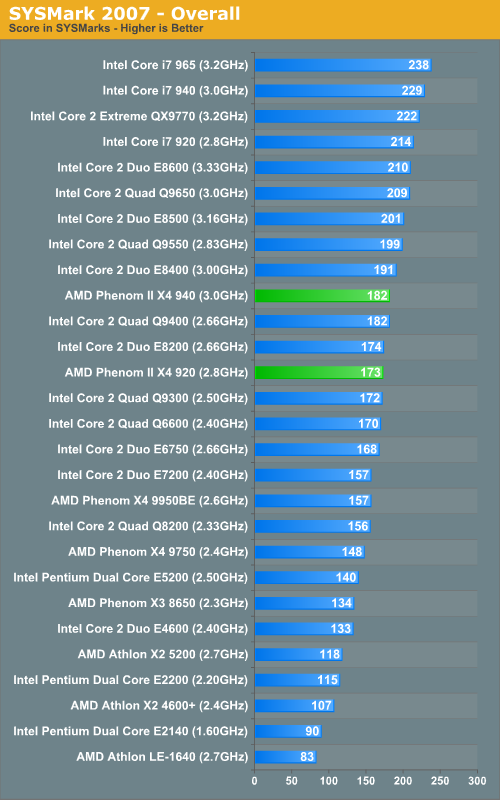
AMD hasn’t done too well under SYSMark 2007, especially with Phenom - it was just never competitive. There were even murmurs of AMD complaining about its poor performance under SYSMark 2007 not too long ago. The complaints never went anywhere because Phenom II addressed the shortcomings. SYSMark 2007 favors larger caches and the original Phenom left its cores cache-starved. With 1.5MB of L3 cache per core, Phenom II now offers the same performance as its closest cost competitors under SYSMark 2007.
The Phenom II X4 940 gets the exact same score as the Core 2 Quad Q9400. The Phenom II X4 920 equals the performance of the Q9300, which is actually a bit more expensive than AMD’s proposed price. If the two were competing against the Q9550 and Q9400, respectively, AMD would go back to trailing Penryn.
The older Phenom processors are mostly worthless here - Intel’s Core 2 Quad Q6600 outperforms the Phenom X4 9950 by 8%, and that’s with CnQ disabled. Turn on CnQ and the performance gap grows to a noticeable 25%. One of the biggest advantages of Phenom II is that you can have CnQ enabled without the painful performance impact.
It’s worth pointing out the sort of performance you can get out of a high frequency dual-core CPU here. The Core 2 Duo E8600 is a bit expensive for a dual-core, priced at $266, but it offers the same performance as the Core 2 Quad Q9650. The more affordable Core 2 Duo E8400 runs at 3.0GHz, priced at $166, and outperforms all sub-2.66GHz quad-core Core 2 chips. While a quad-core will last you longer, if you are a frequent upgrader it’s worth paying attention to the dual-core market. An E8400 today, followed by a mainstream Nehalem next year, could be your path to performance enlightenment.
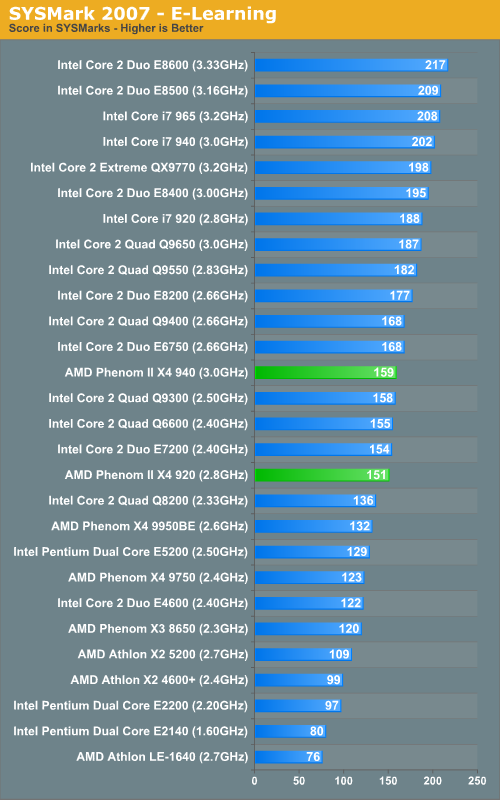
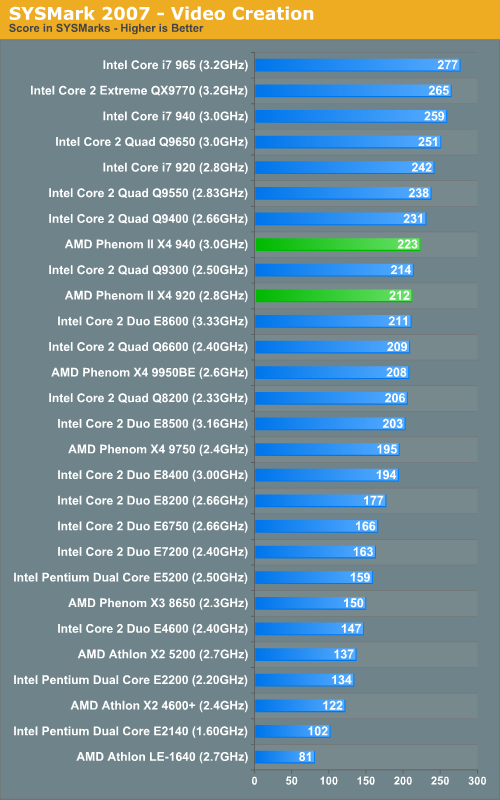
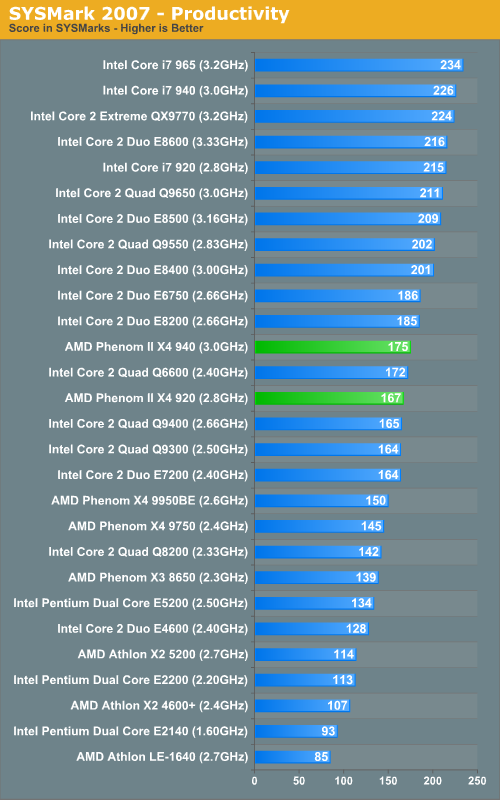
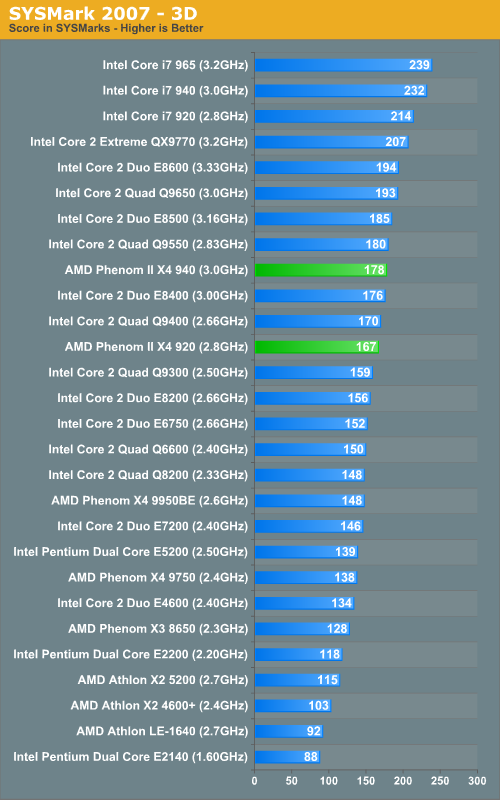
Adobe Photoshop CS4 using Retouch Artists Speed Test
The Photoshop test does basic photo editing; there are a couple of color space conversions, many layer creations, color curve adjustment, image and canvas size adjustment, unsharp mask, and finally a gaussian blur performed on the entire image. The whole process is timed and thanks to the use of Intel's X25-M SSD as our test bed hard drive, performance is far more predictable than back when we used to test on mechanical disks.
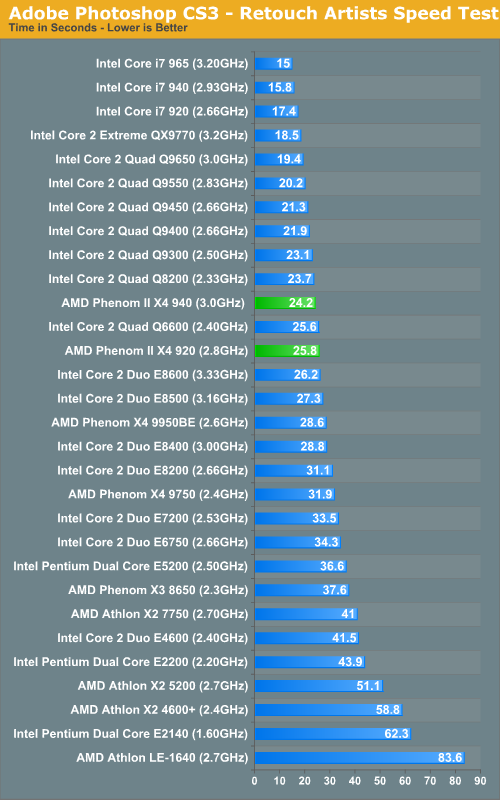
For the type of image manipulations the Retouch Artists speed test performs, Intel's Core 2 and Core i7 CPUs are the better performers. Cache appears to have a very strong impact here; Penryn based Core 2s are around 8 - 10% faster than their 65nm counterparts.
Phenom II is 7.5% faster than the original Phenom here. The Phenom II X4 940 is unable to outperform its closest cost competitor, Intel's Core 2 Quad Q9400. The Q9400 is 9.5% faster. The same is true about the Phenom II X4 920 vs. Intel's Core 2 Quad Q8200/Q8300. While we only tested the Q8200, it's still 8% faster than the Phenom II X4 920.
With the new Phenom unable to be competitive here, the old Phenom doesn't fare any better. The Phenom X4 9950 is over 10% slower than the Core 2 Quad Q6600, the first quad-core we all fell in love with.
The benefit of four cores is higher than expected in Photoshop; looking at a dual vs. quad-core Penryn, there's around a 30% performance boost from moving to four cores at the same clock speed. If you use Photoshop a lot, quad-core is the way to go.
DivX 8.5.3 with Xmpeg 5.0.3

Now this is a tremendous victory for AMD. The Phenom II X4 940 doesn't break any performance records, nor can it outshine the Core i7 920, but what it does do is offer the same DivX encoding performance as Intel's Core 2 Quad Q9400. The cache and clock speed advantages are just too much for Intel's parts.
x264 HD Encode
Graysky's x264 HD test uses the publicly available x264 codec (open source alternative to H.264) to encode a 4Mbps 720p MPEG-2 source. The focus here is on quality rather than speed, thus the benchmark uses a 2-pass encode and reports the average frame rate in each pass.
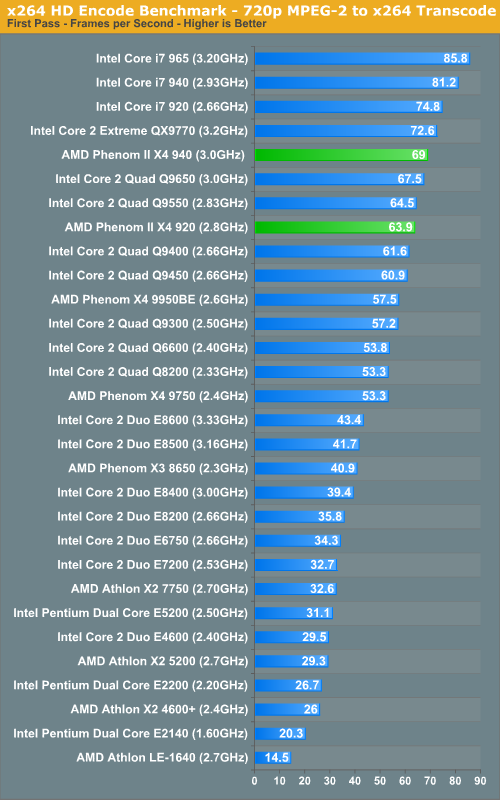
The first pass of the x264 test is a very unique win for AMD; clock for clock it's faster than Penryn here. The trick is that the first pass of the x264 test is mostly an analysis pass, which really benefits from Phenom's integrated memory controller. It's an advantage that no amount of cache can overcome.

The second pass of the x264 encode is where the majority of the work gets done, hence the lower frame rates. The actual encode is happening here and the Phenom II X4 940 ties the performance of the Core 2 Quad Q9400. The same goes for the Phemom II X4 920 and the Q9300. The Q9550 and the Q9400 are faster than the 940 and 920 respectively, but Intel needs to reduce the pricing on both of those parts to remain competitive.
Windows Media Encoder 9 x64 Advanced Profile
Windows Media Encoder has always been an AMD favorite and Phenom II does extremely well here. Again, clock for clock we're at the same performance levels of Penryn, thanks to Phenom's IMC. The Phenom II X4 940 and 920 both outperform their price competitors; in fact, they both perform outside of their price class.
3dsmax 9 - SPECapc 3dsmax CPU Rendering Test
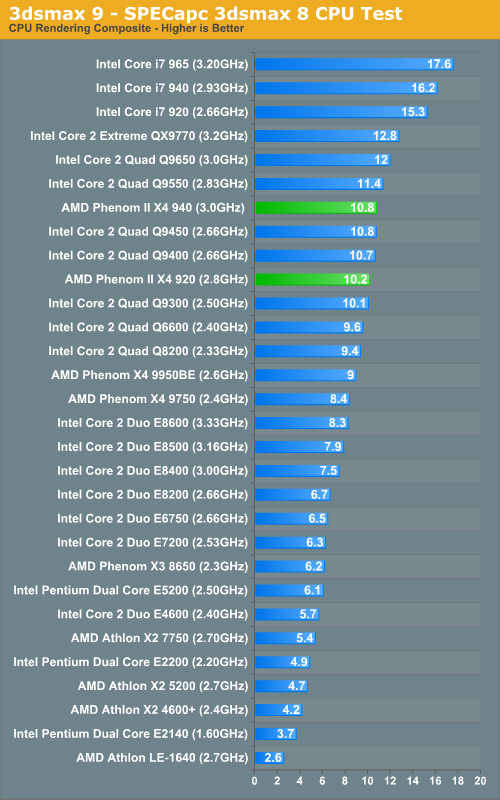
With Phenom II, AMD appears to have created its own honest Penryn competitor - the Q9400 and the X4 940 are in a virtual tie for performance. The Phenom II X4 920 and the Q9300 are close, meaning that it should be a bit faster than the Q8300.
Cinebench R10
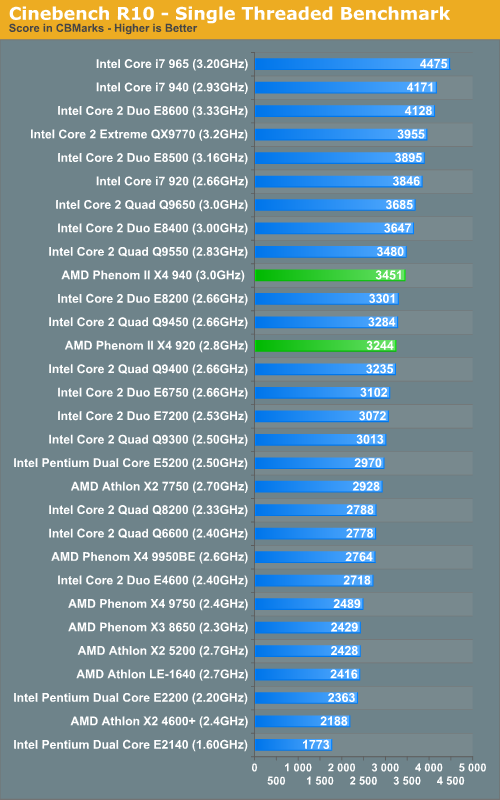
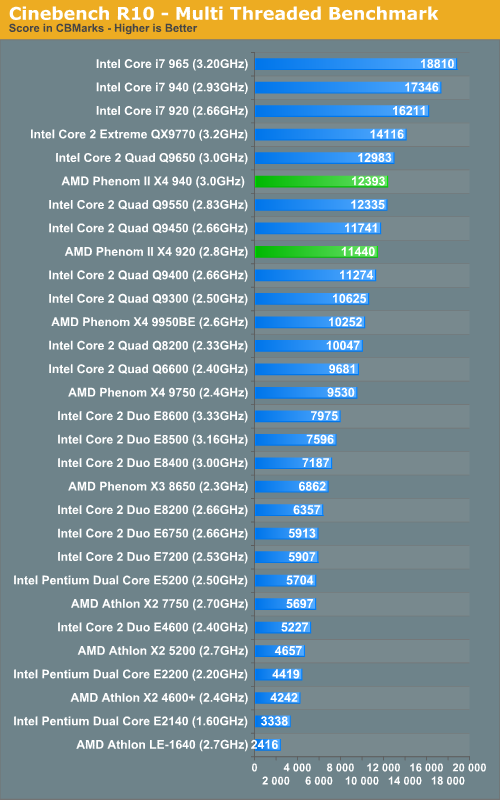
Both Phenom II models are very competitive in the Cinebench when comparing price points, but still trail the Intel Core 2 processors slightly on a clock per clock basis.
POV-ray 3.7 Beta 23

Once again, the Phenom II is very competitive on a cost basis in this 3D rendering application while remaining very close to the Core 2 series on a clock speed basis.
Multi-threaded par2 Archive Recovery
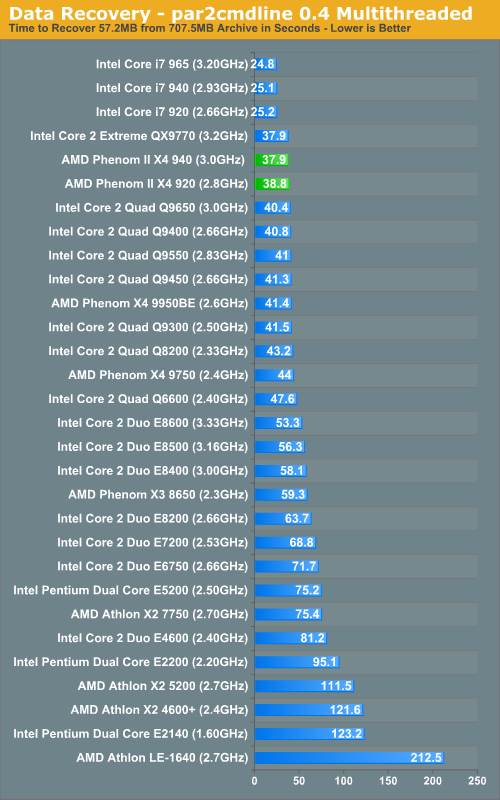
Our Data Recovery test shows Phenom II equalling or bettering the Core 2 series due to a test that favors the IMC designs over the cache centric Core 2.
Blender 2.48a
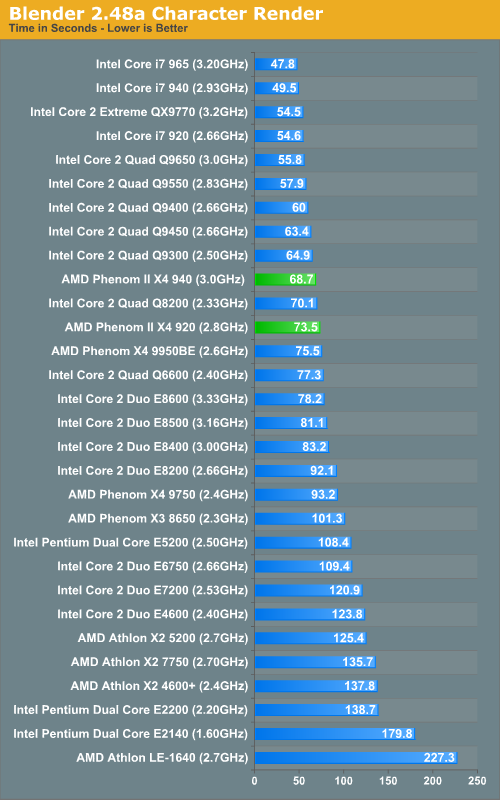
Blender shows Phenom II less competitive than the other 3D rendering tests we've seen thus far.
Microsoft Excel 2007
Just as there are applications that favor the Phenom II's IMC, there are those scenarios that are highly optimized for Intel's architectures. Running the Excel Monte Carlo simulation all of the Core 2 Quads and even the Core 2 Duo E8600 are faster than AMD's Phenom II. This is simply a test that is highly optimized for Intel's architectures, which is a big reason Intel prefers it. But it's real world and it's worth identifying.
Sony Vegas Pro 8: Blu-ray Disc Creation
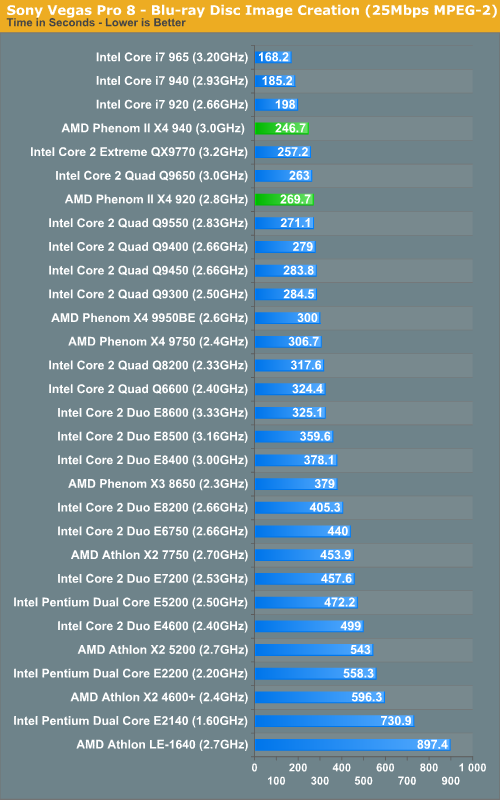
Encoding yet again, and Phenom II does very well. This time around we're creating a Blu-ray disc, something that will perhaps become more common place in the next couple of years. Other than the Core i7, Phenom II is the fastest processor around. It's the strength of the integrated memory controller at work - both Core i7 and Phenom II rule the charts here. Penryn is good but not good enough, even at the same clock speed, to compete.
Sorenson Squeeze: FLV Creation
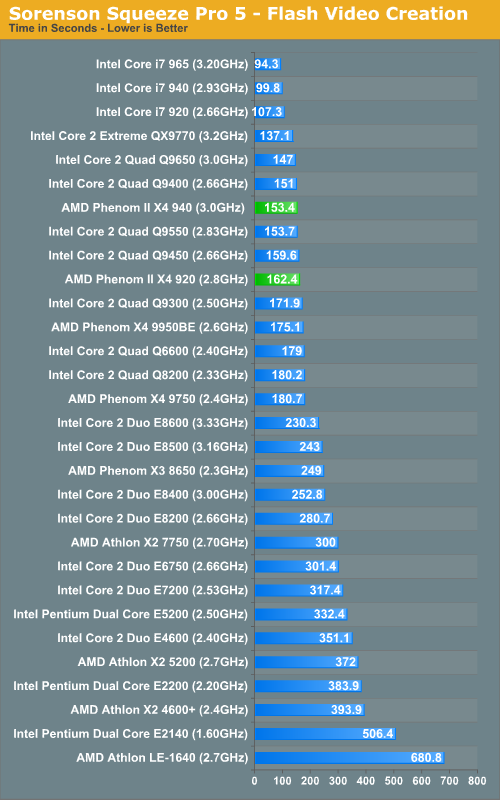
There's a certain degree of variability between the runs here which is why we see the Q9400, Q9550 and Phenom II X4 940 all around the same level of performance. The takeaway point? AMD is fully competitive here, and a real alternative to Intel's Core 2 Quad at the same price point and beyond.
WinRAR - Archive Creation
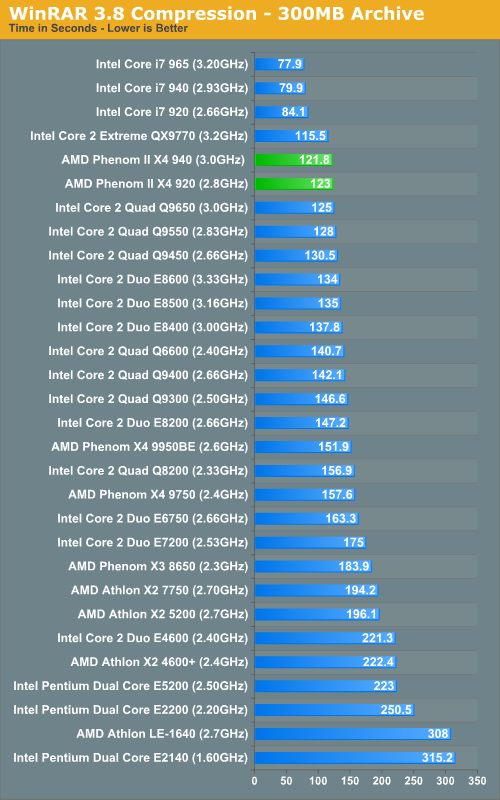
Compression programs love multiple cores and fast memory access. This test bodes well for the Phenom II's IMC design and it shows with results besting all of the Core 2 processors except for the $1100+ QX9770.
Fallout 3
Bethesda's latest title uses an updated version of the Gamebryo engine.

Left 4 Dead

The Phenom II might not match the Core 2 series on a clock for clock basis in these two games, but performs very well compared to the Q9400 and Q8200. Overall gaming compatibility and stability was excellent with the 940 and 920 on the MSI 790GX based motherboard.
FarCry 2
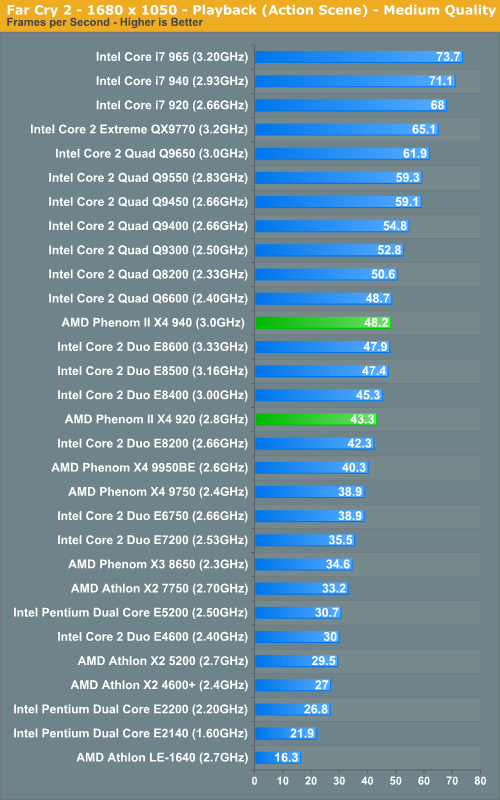
FarCry 2 is an interesting game because it makes real use of more than two cores, which propels Core i7 to the top of the charts. FarCry 2 also ends up being very favorable to Intel architectures.
Crysis Warhead
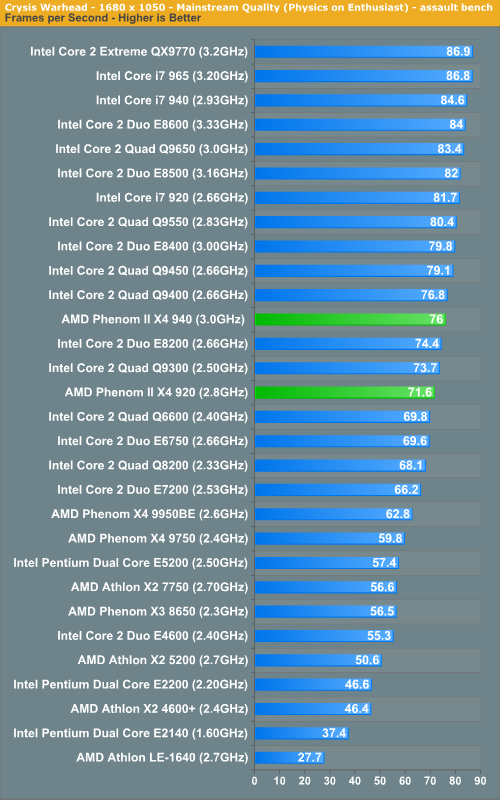
Gaming Summary
Gaming performance was traditionally a weak point of Phenom. AMD often argued that Phenom's gaming performance was good enough, but with a better alternative at the same price point there was no reason to settle. With Phenom II, thanks to higher clock speeds and more cache, AMD now has a competitive gaming CPU. The Phenom II X4 940 and Core 2 Quad Q9400 are nearly identical in performance; AMD could not have positioned or priced this CPU any better. The Q9550 is a bit faster but, at least for now, it comes with a higher price tag as well. The Phenom II X4 920 is also right where it needs to be: between the Q8200 and the Q9300.
Final Words
Architecturally, Phenom II is what the original Phenom should have been. It's not cache starved, and while not as balanced as Core i7, it's a step in the right direction.
Compared to the Core 2 Quad Q9400, the Phenom II X4 940 is clearly the better pick. While it's not faster across the board, more often than not the 940 is equal to or faster than the Q9400. If Intel can drop the price of the Core 2 Quad Q9550 to the same price as the Phenom II X4 940 then the recommendation goes back to Intel. The Q9550 is generally faster than the 940, more overclockable at lower voltages, and a high enough default clock speed to keep you happy in the long run.
The same goes for the Phenom II X4 920 vs. Q9300/Q8200; AMD wins that comparison at the same price point. Compared to the Q9400, the Phenom II X4 920 falls behind. The Q9400 is the better buy of the two, but only if Intel does come through with rumored price cuts. We'll know for sure by the end of the month.
AMD also thankfully produced a good overclocker, at least with our review samples. The fact that we weren't able to overclock too high without increasing the core voltage is a testament to the early nature of AMD's 45nm process. Core i7, on the other hand, was basically able to reach maximum clock speed without so much as touching the voltage dials. Remember that Core i7 is Intel's second 45nm processor while Phenom II is AMD's first; it will only get better with time.
Looking through the performance results, it's also worthwhile to recognize just how fast Intel's Core i7 is. Across the board Core i7 is the fastest thing out there. If the motherboard guys could get X58 board pricing down below $200 and DDR3 memory was available at the same price as DDR2, then the i7-920 would be the clear recommendation. The entry-level Core i7 is pretty much faster than the-top end Core 2 Extreme or the Phenom II. When I originally reviewed Conroe I wrote that it was the world's fastest microprocessor; Core i7 continues to hang on to that title.
Despite Intel's strengths, AMD was able to do very well here today with Phenom II. Being able to have a CPU competitive with Penryn right out of the gates is worthy of a commendation. The scary part is that Intel could easily mitigate AMD's gains here with some simple price adjustments. Even more worrisome for AMD is that Phenom II is its only foot forward until 2011 when the first Bulldozer based CPUs arrive. There's headroom in AMD's 45nm process, but what happens when Core i7 goes mainstream? We must not forget that Phenom II is competitive with a 45nm derivative of a 2+ year old architecture.
If you have a Socket-AM2+ motherboard with BIOS support for Phenom II there's no question - Phenom II is the best upgrade path for you. If you are trying to build a new system from scratch, I'd suggest waiting for either the Socket-AM3 CPUs or see what Intel does with its pricing later this month.
Phenom II is AMD's return to competition, and unlike the best the original could do, the sequel is actually worthwhile. Even if Intel drops prices to maintain control of the quad-core market, you have AMD to thank for that. It's similar to what happened in the GPU market last summer: competition keeps prices in check. Economic woes or not, both AMD and Intel are going to be fighting hard for your business this year.

